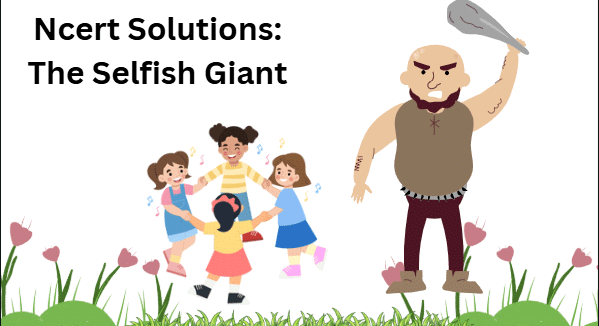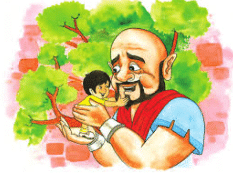NCERT Solutions for Class 8 English It So Happened Chapter 3 - The Selfish Giant

Comprehension Check- I
Q1. Why is the Giant called selfish?
Ans: The Giant is considered selfish because he refused to let the children play in his garden. He constructed a high wall around it and displayed a notice board warning that trespassers would be prosecuted. This behaviour left the children with nowhere to play, highlighting his selfishness.
Q2. On one occasion the children said: “How happy we are here!” Later they said: “How happy we were there!” What are they referring to in both cases?
Ans: In the first instance, the children express their joy in the Giant's garden, where they play after school. They cherish the fun they have there. In the second instance, they reminisce about their happiness in the same garden, reflecting on the time before the Giant forbade them from playing. Thus, in both cases, the children are referring to the Giant's garden.
Q3. (i) When spring came, it was still winter in the garden. What does winter stand for or indicate here?
Ans: In the story, winter represents a negative and lifeless environment. It signifies a place where trees and flowers do not bloom, creating an atmosphere of depression and laziness. This winter also embodies feelings of sadness and a longing for happiness. The absence of singing birds, playing children, and the arrival of spring indicates that winter has overstayed its welcome in the garden.
Q4. (ii) Winter has been presented as a story with its own characters and their activities. Describe the story in your own words.
Ans: In the story of winter, when spring arrived, the birds remained silent because there were no children to play. The trees also failed to blossom. A flower peeked out from the grass but, upon seeing the giant's notice board, felt sad for the children and retreated back into the ground to sleep. Meanwhile, snow and frost were quite pleased. The snow blanketed the grass, while the frost coated the trees. They invited the North Wind to join them, and soon after, the Hail came to visit. The Hail rattled on the castle roof daily, causing damage, and then raced around the garden energetically.
Q5. Was the Giant happy or sad over the state of the garden?
Ans: The Giant was upset about the state of his garden, which was trapped in an eternal winter. Spring never arrived, and harsh elements like Northwind, hail, and snow dominated his garden. He could not understand why spring had not come to his garden.
Q6. What effect did the linnet’s song have over Hail and the North Wind?
Ans: The linnet's song had a profound effect on both Hail and the North Wind. When the linnet began to sing, the Hail stopped dancing above the Giant's head, and the North Wind ceased its roaring. This moment marked a shift in the atmosphere, suggesting that the beauty of the linnet's music could calm even the fiercest elements.
Comprehension Check- II
Q1. (i) The Giant saw a most wonderful sight. What did he see?
Ans: The Giant witnessed a wonderful sight when he saw the children had entered the garden through a small hole in the wall. They were joyfully sitting on the branches of the trees, with a child perched in every tree. The trees, delighted to have the children back, had adorned themselves with blossoms and were gently waving their branches. Birds flew around, twittering with happiness, while the flowers and grass seemed to be laughing in delight.
Q2. (ii) What did he realize on seeing it?
Ans: He realized that spring did not come to his garden because he had prevented the children from playing there. He understood that he was selfish for not allowing the children to enjoy his garden. When the children returned, they brought back happiness with them, and with their presence, spring finally arrived.
Q3. Why was it still winter in one corner of the garden?
Ans: In one corner of the garden, a tree was completely covered with frost and snow. The North Wind was howling above it, creating a cold atmosphere. A little boy stood nearby, unable to reach the tree's branches. Consequently, this area remained in a state of winter.
Q4. Describe the first meeting of the little boy and the Giant.
Ans: The first meeting of the little boy and the Giant took place beneath a tree covered in frost and snow. The Giant gently lifted the boy and placed him in the tree. Instantly, the tree blossomed, and birds began to sing. The little boy, filled with joy, wrapped his arms around the Giant's neck and kissed him.
Q5. Describe their second meeting after a long interval.
Ans: Their second meeting occurred on a winter morning after a long time apart. The Giant was astonished to see a tree in the far corner of the garden, adorned with beautiful white blossoms. Its branches sparkled with golden hues, and silver fruit hung from them. Beneath this tree stood the little boy. Filled with joy, the Giant rushed towards him. However, as he approached, his expression changed to one of anger upon noticing the nail imprints on the child's hands and feet. The Giant demanded to know who had hurt him, vowing to slay the culprit.
The child calmly replied that these were the wounds of love. Overcome with awe, the Giant knelt before the boy and asked who he was. The child smiled and reminded the Giant that because he had once allowed him to play in his garden, he would now take him to his own garden, which was paradise.
Later that afternoon, when the children returned, they found the Giant lying dead beneath the tree, covered in white blossoms.
Q6. The Giant lay dead, all covered with white blossoms. What does this indicate about the once selfish Giant?
Ans: The Giant transformed during his life. Initially, he was cruel and selfish, but he eventually embraced love and humanity. His death, marked by being covered in white blossoms, signifies his change of heart. These flowers represent peace and suggest that he was rewarded in the afterlife for his newfound charitable deeds.
Exercise
Q1. The little child’s hands and feet had marks of nails. Who does the child remind you of? Give a reason for your Answer.
Ans: The child reminds one of Jesus Christ. When the Giant encountered the little child again, he noticed the imprints of nails on the child's hands and feet. These marks are reminiscent of the nails that were driven into Christ's palms and feet during his crucifixion. Jesus sacrificed his life for humanity, allowing the sins of the world to be forgiven. This is why the child explained to the Giant that these were the wounds of love.
Q2. Is there something like this garden near where you live? Would you like one (without the Giant perhaps) and why? What would you do to keep it in good shape?
Ans: No, there isn't a garden like that near where I live. However, I would love to have one, as it would create a beautiful space for relaxation and play for everyone nearby. To keep the garden in good shape, we could regularly sweep it to remove dead leaves and hire a gardener to trim the plants and maintain their appearance. Additionally, picking up litter would help keep the area neat and tidy.
|
36 videos|330 docs|56 tests
|
FAQs on NCERT Solutions for Class 8 English It So Happened Chapter 3 - The Selfish Giant
| 1. What is the main theme of "The Selfish Giant"? |  |
| 2. How does the Giant's attitude towards the children change throughout the story? |  |
| 3. What role does the winter symbolize in the story? |  |
| 4. What lesson can be learned from the Giant's experience in the story? |  |
| 5. How does the ending of "The Selfish Giant" convey a message about redemption? |  |

















